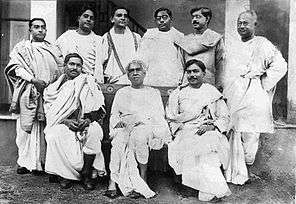Jnanendra Nath Mukherjee
| Jnanendra Nath Mukherjee | |
|---|---|
 Jnanendra Nath Mukherjee (Standing, second from right) with other scientists of Calcutta University | |
| Born | 23 April 1893 |
| Died | 10 May 1983 (aged 90) |
| Occupation | Chemist |
Jnanendra Nath Mukherjee CBE, FRSC (23 April 1893, Mahavdepur, Rajshahi District-today in Bangladesh – 10 May 1983), was a reputed Indian chemist as well as an internationally respected colloid chemist.
Education
Jnanendra Nath Mukherjee obtained his MSc (1915) from University of Calcutta specializing in electrochemistry, colloids, and soil science.[1]
Positions served
He served as the Professor of Chemistry, University of Calcutta. As the director Indian Agricultural Research Institute, New Delhi. JN Mukherjee also served as the Founder Director of Central Building Research Institute, Roorkee and as the Administrator of Board of Secondary Education, West Bengal from 1954-56. From 1956-58 he was the Member of Union Public Service Commission.[1]
Academic and Research Achievements
JN Mukherjee’s work on the electrochemistry of colloids is considered highly significant. He is also well known for the boundary method he developed for determining the cataphoretic speed of colloid particles. His researches also shed light on soil properties and problems.
In 1919, he enunciated theory of the electro kinetic double layer and its ionic constitution.
In 1942, with N.C. Sen Gupta, he developed a simple rotary viscometer for the study of anomalous viscous properties. In 1944, he developed the method of differentiation of crude oils based on chromatography capillary analysis and fluorescence in UV light.[2]
Going beyond the confines of laboratory research, Mukherjee brought to fore the importance of soil surveys for agricultural development. He prepared (with B Viswanath and AC Ukil) soil map of India in 1944 and later revised it in 1954.
Other Contributions
Mr. Mukherjee was responsible for the founding of the Indian National Science Academy as a member of the committee formed in accordance with the resolution adopted at a meeting of the Indian Science Congress Association held on January 3, 1934. He served as Chairman, Homeopathic Enquiry Committee, Sub-committee on Soil Conservation and Afforestation of National Planning Committee of Indian National Congress (1938), as member, Policy Committee on Agriculture, Forestry and Fisheries of Viceroy’s Executive Council (1944–45). As member of Coordination Committee in Science, Government of India,Board and Technical Committee. As the CSIR Vice-President, Indian Statistical Institute, he chaired many technical committees of CSIR, ICAR and of many universities and of Government of West Bengal.[1]
Awards and Honours
- Padma Bhushan (1964)[3]
- Commander of the Order of the British Empire (CBE) (1943 Birthday Honours)[4]
- Fellow of Indian Academy of Science, Bangalore, Indian Chemical Association and Royal Society of Chemistry (London)
- Founder Secretary, Indian Chemical Society, President (1935–36), Indian Society of Soil Science
- Member, Council (1935–38) and as Vice-President (1941–42)
- Foreign Secretary, INSA (1943–44) and (1947–51)
- General President, Indian Science Congress Association (1952).[1]
References
- 1 2 3 4 "INSA profile".
- ↑ "NeglectedScience :: Jnanendra Nath Mukherjee".
- ↑ "Padma Awards" (PDF). Ministry of Home Affairs, Government of India. 2016. Retrieved January 3, 2016.
- ↑ The London Gazette: (Supplement) no. 36033. p. 2434. 28 May 1943. Retrieved 27 August 2015.
External links
- http://www.neglectedscience.com/alphabetical-list/m/jnanendra-nath-mukherjee
- http://insaindia.org/deceaseddetail.php?id=F000489